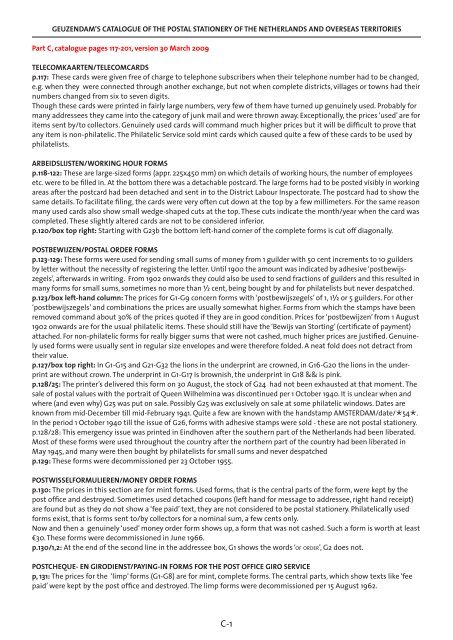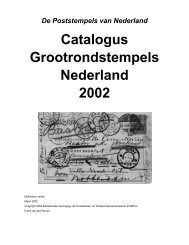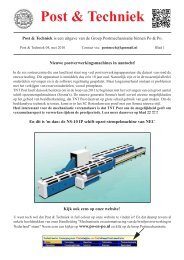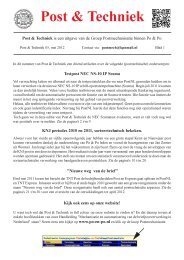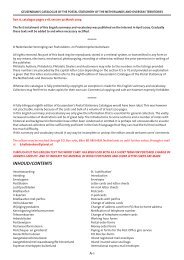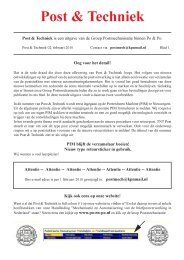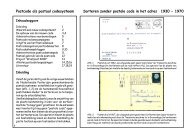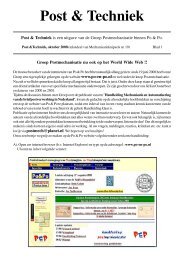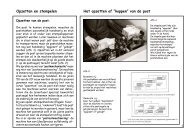GEUZENDAM catalogue pages 117-201
GEUZENDAM catalogue pages 117-201
GEUZENDAM catalogue pages 117-201
You also want an ePaper? Increase the reach of your titles
YUMPU automatically turns print PDFs into web optimized ePapers that Google loves.
<strong>GEUZENDAM</strong>’S CATALOGUE OF THE POSTAL STATIONERY OF THE NETHERLANDS AND OVERSEAS TERRITORIES<br />
Part C, <strong>catalogue</strong> <strong>pages</strong> <strong>117</strong>-<strong>201</strong>, version 30 March 2009<br />
TELECOMKAARTEN/TELECOMCARDS<br />
p.<strong>117</strong>: These cards were given free of charge to telephone subscribers when their telephone number had to be changed,<br />
e.g. when they were connected through another exchange, but not when complete districts, villages or towns had their<br />
numbers changed from six to seven digits.<br />
Though these cards were printed in fairly large numbers, very few of them have turned up genuinely used. Probably for<br />
many addressees they came into the category of junk mail and were thrown away. Exceptionally, the prices ‘used’ are for<br />
items sent by/to collectors. Genuinely used cards will command much higher prices but it will be diffi cult to prove that<br />
any item is non-philatelic. The Philatelic Service sold mint cards which caused quite a few of these cards to be used by<br />
philatelists.<br />
ARBEIDSLIJSTEN/WORKING HOUR FORMS<br />
p.118-122: These are large-sized forms (appr. 225x450 mm) on which details of working hours, the number of employees<br />
etc. were to be fi lled in. At the bottom there was a detachable postcard. The large forms had to be posted visibly in working<br />
areas after the postcard had been detached and sent in to the District Labour Inspectorate. The postcard had to show the<br />
same details. To facilitate fi ling, the cards were very often cut down at the top by a few millimeters. For the same reason<br />
many used cards also show small wedge-shaped cuts at the top. These cuts indicate the month/year when the card was<br />
completed. These slightly altered cards are not to be considered inferior.<br />
p.120/box top right: Starting with G23b the bottom left-hand corner of the complete forms is cut off diagonally.<br />
POSTBEWIJZEN/POSTAL ORDER FORMS<br />
p.123-129: These forms were used for sending small sums of money from 1 guilder with 50 cent increments to 10 guilders<br />
by letter without the necessity of registering the letter. Until 1900 the amount was indicated by adhesive ‘postbewijszegels’,<br />
afterwards in writing. From 1902 onwards they could also be used to send fractions of guilders and this resulted in<br />
many forms for small sums, sometimes no more than V cent, being bought by and for philatelists but never despatched.<br />
p.123/box left-hand column: The prices for G1-G9 concern forms with ‘postbewijszegels’ of 1, 1V or 5 guilders. For other<br />
‘postbewijszegels’ and combinations the prices are usually somewhat higher. Forms from which the stamps have been<br />
removed command about 30% of the prices quoted if they are in good condition. Prices for ‘postbewijzen’ from 1 August<br />
1902 onwards are for the usual philatelic items. These should still have the ‘Bewijs van Storting’ (certifi cate of payment)<br />
attached. For non-philatelic forms for really bigger sums that were not cashed, much higher prices are justifi ed. Genuinely<br />
used forms were usually sent in regular size envelopes and were therefore folded. A neat fold does not detract from<br />
their value.<br />
p.127/box top right: In G1-G15 and G21-G32 the lions in the underprint are crowned, in G16-G20 the lions in the underprint<br />
are without crown. The underprint in G1-G17 is brownish, the underprint in G18 && is pink.<br />
p.128/25: The printer’s delivered this form on 30 August, the stock of G24 had not been exhausted at that moment. The<br />
sale of postal values with the portrait of Queen Wilhelmina was discontinued per 1 October 1940. It is unclear when and<br />
where (and even why) G25 was put on sale. Possibly G25 was exclusively on sale at some philatelic windows. Dates are<br />
known from mid-December till mid-February 1941. Quite a few are known with the handstamp AMSTERDAM/date/54.<br />
In the period 1 October 1940 till the issue of G26, forms with adhesive stamps were sold - these are not postal stationery.<br />
p.128/28: This emergency issue was printed in Eindhoven after the southern part of the Netherlands had been liberated.<br />
Most of these forms were used throughout the country after the northern part of the country had been liberated in<br />
May 1945, and many were then bought by philatelists for small sums and never despatched<br />
p.129: These forms were decommissioned per 23 October 1955.<br />
POSTWISSELFORMULIEREN/MONEY ORDER FORMS<br />
p.130: The prices in this section are for mint forms. Used forms, that is the central parts of the form, were kept by the<br />
post offi ce and destroyed. Sometimes used detached coupons (left hand for message to addressee, right hand receipt)<br />
are found but as they do not show a ‘fee paid’ text, they are not considered to be postal stationery. Philatelically used<br />
forms exist, that is forms sent to/by collectors for a nominal sum, a few cents only.<br />
Now and then a genuinely ‘used’ money order form shows up, a form that was not cashed. Such a form is worth at least<br />
€30. These forms were decommissioned in June 1966.<br />
p.130/1,2: At the end of the second line in the addressee box, G1 shows the words ‘OF ORDER’, G2 does not.<br />
POSTCHEQUE- EN GIRODIENST/PAYING-IN FORMS FOR THE POST OFFICE GIRO SERVICE<br />
p, 131: The prices for the ‘limp’ forms (G1-G8) are for mint, complete forms. The central parts, which show texts like ‘fee<br />
paid’ were kept by the post offi ce and destroyed. The limp forms were decommissioned per 15 August 1962.<br />
C-1
<strong>GEUZENDAM</strong>’S CATALOGUE OF THE POSTAL STATIONERY OF THE NETHERLANDS AND OVERSEAS TERRITORIES<br />
p.132: There are 3 columns for the Hollerith punch cards:<br />
- 1st column complete mint forms,<br />
- 2nd column used ‘stortingskaart’, that is the left hand part of the form,<br />
- 3rd column used certifi cate of payment, that is the right hand part of the form.<br />
Both parts show the text ‘fee paid’ and both are therefore considered to be collectible postal stationery. The ‘stortings-kaarten’<br />
were sent to the payees, who often preserved them in their fi les. Such parts often show punchholes or small staple<br />
holes. Though perhaps less desirable, they are worth collecting.<br />
The ‘stortingskaarten’ of G10, G11 and G12 cannot be distinguished with the exception of forms used before 1 January<br />
1964, which are G10. Certifi cates of payment are frequently found with additional stamps to pay for a new rate.<br />
These forms were decommissioned per 1 November 1966<br />
BUSRECHTFORMULIEREN/P.O. BOX FEE FORMS<br />
p.133: These forms, which were not recognized as postal stationery until 1961, were receipts for the fee paid for the right to<br />
collect letters etc. at the post offi ce for a period of three months, the forerunner of the P.O. Box system. The fee depended<br />
on the number of inhabitants of a town. There was a separate fee for newspapers collected at the post offi ce. For registered<br />
letters there was an annual fee. The list may not be complete. The forms are printed on coloured paper, for some<br />
values the reverse is white. The quality of the paper is poor and some shades fade easily.<br />
Prices from €120 are justifi ed. These forms were decommissioned per 1 October 1919.<br />
AANGETEKEND BINNENLAND/INLAND REGISTERED MAIL ENVELOPES<br />
p.136: The fi rst issue of the Inland registered mail envelopes (G1) was available at a very limited number of post offi ces<br />
during a short trial period, 3 June 1996-31 December 1996. The Registered envelopes are made of stiff cardboard.<br />
Both G1 and G2 have stuck-on shipping documents.<br />
These items should be collected with the attached complete shipping document when mint, with the bottom sheet of<br />
the shipping document still attached when used.<br />
The sale of the inland registered envelopes was discontinued per 31 May 2000.<br />
AANGETEKEND MET WAARDEAANGIFTE BINNENLAND/INLAND ‘INSURED VALUE’ SEALBAGS<br />
p.139: The fi rst issue of the Inland registered sealbags (G1) was available at a very limited number of post offi ces during<br />
a very short trial period, 2 September 1996-31 December 1996. The sealbags are made of plastic.<br />
All these sealbags have stuck-on shipping documents.<br />
These items should be collected with the attached complete shipping document when mint, with the bottom sheet of<br />
the shipping document still attached when used.<br />
The sale of sealbags was discontinued, probably early in 2007.<br />
EXPRESSE-ENVELOPPEN BUITENLAND/INTERNATIONAL PREPAID EXPRESS MAIL ENVELOPES<br />
p.140: All these envelopes have stuck on the back a transparent envelope containing the shipping document. Mint<br />
items should have the complete shipping document, used items the bottom sheet of the shipping document.<br />
EXPRESSE-ENVELOPPEN BINNENLAND/INLAND PREPAID EXPRESS MAIL ENVELOPES<br />
p. 143:The fi rst issue of the Inland prepaid express mail envelopes (G1) was available at a very limited number of post<br />
offi ces during an extremely short trial period, 13 November 1996-31 December 1996.<br />
G1, G2 and G7-G10 have stuck-on shipping documents. These items should be collected with the attached complete<br />
shipping document when mint, with the bottom sheet of the shipping document still attached when used.<br />
G3-G6 have stuck on the back a transparent envelope containing the shipping document. Mint items should have the<br />
complete shipping document, used items the bottom sheet of the shipping document.<br />
The sale of these envelopes was discontinued in September 2007.<br />
EXPRESSEZEGELS BINNENLAND/INLAND PREPAID EXPRESS MAIL LABELS<br />
p.146: At fi rst these labels were sold side by side with the prepaid express mail envelopes, but from September 2007 they<br />
replaced these envelopes.<br />
CASSETTEPOST<br />
p.149,1: The strip for the cancellation of G1a consists of only one layer of paper, with G1b this strip consists of a double<br />
layer of paper.<br />
C-2
<strong>GEUZENDAM</strong>’S CATALOGUE OF THE POSTAL STATIONERY OF THE NETHERLANDS AND OVERSEAS TERRITORIES<br />
PTT POST KADOSERVICE/PTT POST GIFT SERVICE<br />
p.150-153: Muziekpost (Musicpost), Flespost (Bottlepost), Cosmeticapost (Cosmeticspost) and Boekpost (Bookpost) are precut<br />
sheets of cardboard that after folding provide containers for 1 or 2 compact discs, for 1 or 2 bottles, for a ‘cosmeticsgift’<br />
(though size nor design nor text make this purpose clear), for a book. Initially they were available in shops, later<br />
they were also sold by the Post.<br />
p.150: ‘Berenpost’ (Bearpost) was a very shortlived trial. It is a self-adhesive address label that was sold in post offi ce<br />
shops together with a teddy-bear in a cardboard cylinder. The existence of this label was only discovered by collectors<br />
after it had been withdrawn. Only lately the existence of a used label has come to light.<br />
ROODE KRUIS PAKKET-ETIKET/RED CROSS PARCEL LABEL 1945<br />
p.154: This label was used during a very short period (3 weeks in April 1945) in the liberated southern provinces. It was used<br />
to frank foodparcels destined for the northern provinces, at that moment still occupied, to be despatched immediately<br />
after liberation.<br />
EUROPAKKETZEGELS/LABELS EUROPEAN PARCEL POST<br />
p.155: These stick-on three sheet labels could be used for parcels to destinations in the European Union, Norway and<br />
Switzerland. Zone 1 comprised Belgium, Luxemburg and Germany, zone 2 the other countries. There were fi ve weight<br />
steps. In the Christmas periods of 1998, 1999 and 2000 the maximum of the fi rst weight step was increased from 1 kilo<br />
to 3 kilos (G11-G16). The top sheet served as receipt, the second and third sheet were stuck on the parcel. In theory the<br />
post in the country of the addressee kept the second part (proof of delivery) but quite often omitted to do so. The third<br />
sheet remained on the parcel. Mint copies should have all three sheets, used is for the second and/or third sheet, which<br />
both have the text ‘taxe perçue’. In theory all three sheets should be postmarked. These labels are quite rare and even<br />
the fi rst sheet (proof of posting) with a postmark is a desirable item.<br />
The sale of these labels was suspended per 1 July 2001 but they remained valid. Even now, 2009, they can (in theory) still<br />
be used though probably they will not be recognized by postal clerks.<br />
PAKKETZEGELS/LABELS INLAND PARCEL POST<br />
p. 158:Though with the exception of G28a and G30 – G33 these labels do not comply with the FIP defi nition of postal<br />
stationery, many collectors consider them ‘related postal products’, a good enough reason for us to include them. Moreover,<br />
if they were not <strong>catalogue</strong>d here, collectors would have to do without a (clear) listing.<br />
PARTICULIERE EN BEPERKT VERKRIJGBARE POSTWAARDESTUKKEN/<br />
PRINTED TO ORDER POSTAL STATIONERY AND POSTAL STATIONERY THAT WAS NOT GENERALLY AVAILABLE<br />
Numbering system:<br />
Printed to Order items based on existing regular items<br />
take the number of that regular item preceded by a<br />
single P.<br />
Printed to Order items that are not based on existing<br />
items get PP + the last two digits of the year of issue +<br />
a serial number.<br />
In the Netherlands only two issues are Stamped To Order<br />
(STO): A-3 and A-6.<br />
P273 and P330a, and perhaps P211a-b/P216a-b, are in a<br />
category by themselves: Overprinted to Order.<br />
All the other issues in this chapter are Printed To Order<br />
(PTO).<br />
In this chapter we deal with three categories:<br />
A. Envelopes, air mail letter sheets, postcards, money orders, paying-in forms for the Post Offi ce giro service and casssettepost<br />
envelopes that were ordered with the Post Offi ce by private persons or businesses for their own use or for the use<br />
of their customers.<br />
B. A variety of postal stationery items produced for or with the cooperation of the Post Offi ce which for one reason or<br />
another were not generally on sale but were meant to be used by the general public.<br />
C. Special issues<br />
C-3
<strong>GEUZENDAM</strong>’S CATALOGUE OF THE POSTAL STATIONERY OF THE NETHERLANDS AND OVERSEAS TERRITORIES<br />
p.168-176/A-1: From 1908 to 1917 envelopes and postcards could be ordered with sender’s adddress instead of the usual<br />
sender’s lines. On envelopes this address can be found either on the back fl ap or in the lower left corner on the address<br />
side or left of the stamp imprint, in all three cases the sender’s lines on the back fl ap were omitted. On postcards they<br />
are found in the lower left corner on the address side. Postcards which show sender’s lines and a printed sender’s address<br />
are not PTO items.<br />
p.168/LIJST 1: Listing of all the envelopes and postcards that at one time or another have been reported by collectors.<br />
Items with an asterisk (*) have not been seen by the editors of this edition.<br />
p.174/LIJST 2: The data for this list of PTO items which are supposed to have been produced, have been taken from offi cial<br />
sources. The list was originally published in 1993. Since then a few have been found. In the list these have been crossed<br />
out lightly (e.g. p. 175 left hand column W. Jochems) and the number under which they have been incorporated in list 1, has<br />
been added. There is uncertainty about the exact texts as the archival records have been destroyed.<br />
p.177/A-2: In 1924 a reorganisation of the Postal giro service proved to be more fundamental than expected and brought<br />
operations to a complete standstill. In order to be able to collect payments the waterboard for the province of Noord-<br />
Holland decided to provide money orders for their customers. Only mint complete forms are known, the majority with<br />
the sum due entered in ink, the name and address of the customer printed on the left hand coupon. The four varieties<br />
can be recognized by the vertical text on the right hand coupon (1E, 2E, 3E or 4E kwartaal = quarter). Forms without name,<br />
address and sum due are very scarce.<br />
In the 1940s, 1950s and 1960s a number of fi rms (banks, insurance companies, etc.) used private postal orders to make<br />
payments. They generally show ‘recht betaald’ (fee paid) or similar texts. It is not yet clear if they all - or indeed any of<br />
them - are postal stationery in the sense of the FIP-defi nition, that is the ‘fee’ was paid beforehand. Some uncashed<br />
items have been preserved (top p.178).<br />
p.178/A-3: From August to November 1929 the Turco-Egyptian Import company used a fairly large number of these reply<br />
envelopes. The most likely use was to enable tobacconists to send in their orders at no cost. The text ‘propaganda department’<br />
on the envelope is however enigmatic. No mint copies are known, all the used copies have a vertical fold. This was a,<br />
perhaps informal, arrangement with the central post offi ce at The Hague. The ‘stamp’ is an imprint of a dateless red machine<br />
frank. There was no date, the envelopes could be used at any moment, the postage had been prepaid so these envelopes<br />
are STO items.<br />
p.178-179/A-4: In the early 50s the Royal Rotterdam Lloyd shipping company ordered ‘personalized’ Air mail letter sheets<br />
These were on sale on board of their ships, both for passengers and for crew. On the inside there is a crowned RL monogram,<br />
on the address side there are printed sender’s lines in which only the name of the ship had to be fi lled in.<br />
In the early 60s the SMN (Steam Shipping Company Nederland) used similar air mail letter sheets. The problem is that no<br />
archival records concerning these letter sheets have been found. It is therefore uncertain whether they are PTO items or<br />
regular air mail letter sheets (which could be bought unfolded) on which illustration etc. had been added at a later moment.<br />
p.179/A-5: These PTO paying-in forms for the post offi ce giro service have so far only been found in the Postal Museum.<br />
The Fridor factory gave such forms to their customers so that they could easily and at no cost to them pay their bills.<br />
p.180/A-6: These picture postcards of holiday camp Witterzomer, may be compared to the Turco-envelopes (A-3). The<br />
management thought that selling postcards and stamps separately took too much time and trouble. Therefore the post<br />
offi ce at Groningen was asked to frank great numbers of postcards with their franking machine. As such franks must be<br />
used on the date mentioned in the datestamp, the datestamp was taken out of the machine. Thus in a rather informal<br />
way, another postal stationery item was created. In most cases the red machine franks are cancelled with machinecancels<br />
or hand cancels. All four types are known with additional franking in adhesives. PP72-1 was still sold in 1975 with additional<br />
franking of 15 cent in adhesive stamps.<br />
p.180/A-7: This is a precancelled printed-to-order postcard to announce a Reader’s Digest competition. Over 1,250,000<br />
cards of P351a and P351b were printed. An unconfi rmed 1974 source says that of P351b about 60,000 copies were printed.<br />
Only the violetbrown elements and the precancel were printed by Joh. Enschedé, the offi cial printer. All the other elements<br />
were subsequently added. As this sort of card is generally regarded as junk mail, nearly all of the copies of P351a were<br />
thrown away. Reader’s Digest put a small number of the cards of the second run (P351b) at the disposal of collectors.<br />
There is no way of telling whether a card has gone through the post.<br />
p.181/A-8: Three PTO cassette envelopes have so far been found. There may be more. They should not be confused with<br />
some cassette enveloppes produced for PTT Post for internal use.<br />
p.181/A-9: In June 2006 subscribers to the women’s magazine ‘Vriendin’ (Friend) received two copies instead of one + a<br />
large prepaid envelope in which they could send the extra copy to a friend. Very few of these envelopes did not end their<br />
lives in the waste paper basket.<br />
C-4
<strong>GEUZENDAM</strong>’S CATALOGUE OF THE POSTAL STATIONERY OF THE NETHERLANDS AND OVERSEAS TERRITORIES<br />
p.182/B-1/P33,P36: On the occasion of Queen Wilhelmina’s investiture on 6 September 1898, the fellowship ‘Moed, Beleid<br />
en Trouw’ (Bravery, Leadership and Devotion to Duty) asked for permission to issue special postcards that would be sold in<br />
bookshops at 10 cent above face value, but not in post offi ces. Half of the premium was for the bookseller, the other half<br />
for ‘Moed, Beleid en Trouw’. The aim of this fellowship was to support fi nancially soldiers who had been awarded the Military<br />
William Order (comparable to the Victoria Cross) but were destitute.<br />
The usual type of card proved to be unsuitable for the printing of the illustrations on the message side, so the private printer’s<br />
which was to print the illustrations provided sheets of special, thick card which could accommodate four postcards. The offi cial<br />
printer’s Enschedé printed the stamp etc. on the address side and then delivered the sheets to the private printer’s for the printing<br />
of the illustrations etc. The offi cial fi rst day was 31 August, but earlier dates are known.<br />
p.182/B-1/P273: As there was a shortage of 5 cent postcards and as the 7V cent foreign rate postcards could not be used<br />
at that moment due to restrictions on postal communications with other countries, the postmaster of the post offi ce<br />
of Laren interpreted the instructions ‘to serve the public as well as possible’ rather (too) freely and had 1,000 cards overprinted;<br />
the validity of the overprinted cards was later reluctantly confi rmed by the GPO, but the postmaster was offi cially<br />
reprimanded. The high price ‘used’ is for verifi ably non-philatelic cards that have gone through the post.<br />
p.182/B-1/P330a: For the INTERNATIONALE VERKEHRSAUSSTELLUNG in Munich in 1965, PTT had a number of postcards overprinted with<br />
a commemorative text. These were exclusively on sale at the exhibition. So far only postcards with the commemorative<br />
postmark have been seen, none of them mailed. No records concerning the origin of this postcard have been found, but,<br />
with some hesitation, the fact that it was a PTT-product has led to the insertion of this postcard in the <strong>catalogue</strong>.<br />
p.183/B-1/P330b: This card was issued for a competition in aid of ICEM refugee transport. The cards were not sold at post<br />
offi ces but in shops. Competitors were supposed to stick stamps of the ICEM charity issue of January 1966 on this card<br />
in order to participate. All the cards sent in were destroyed. Sometimes cards are found that appear to be ‘used’, but none<br />
of them have served in the way they were supposed to serve: they are all of philatelic origin and without any value.<br />
p.183/B-1/P378a-1–P378a-5: The approaching end of the century, or rather the end of years starting with 19, led to this<br />
issue. All the texts read ‘The century of’, followed by ‘the environment; pollution and responsibility’ (a-1), ‘toys; growing<br />
up playing’ (a-2), ‘liberty; war and peace’ (a-3), ‘leisure; collecting’ (a-4), ‘transport; the world comes nearer’ (a-5). These<br />
postcards were sold in sets, exclusively by the Philatelic Service and at the Postal Museum.<br />
p.183,184/B-1/PP05-1–PP05-4: These postcards were sold in sets at €4,95, at fi rst only by the Philatelic Service, later<br />
- according to information received from some collectors - also at a very limited number of post offi ces.<br />
p.184/B-1/PP06-2–PP06-5: These postcards on the theme Hansa cities were sold in sets at €4,95 by the Philatelic Service.<br />
Postal sales points in those four cities in so far as they had shown an interest in selling these cards, received a number of<br />
cards, but only cards related to their own city.<br />
p.185/B-2: The M&M-boxes of the Private Gift Service were issued as a joint venture of the Post Offi ce and Mars Ltd. in<br />
a very limited number (total 1,500). They were available at a very small number of post offi ces and gift shops during a<br />
short trial period.<br />
p.185/B-3/PP05-5–PP05-7: Though it was not announced as such, it seems reasonable to consider this a trial issue. The<br />
Post Offi ce issued these prepaid fold-and-send cardboard boxes in cooperation with eBay and Marktplaats (Marketplace),<br />
both internet marketplaces. They were only valid within the Netherlands. On the box there was a printed inland<br />
parcel post label, the track&trace barcode however was on a separate selfadhesive label. The boxes could only be ordered<br />
in multiples of ten. It seems that most boxes were not postmarked. The very great majority of the small number that<br />
was produced, ended up in the waste paper basket. It is believed that this trial came to an end towards the end of 2006.<br />
p.186/B-3/PP06-6: this number should read PP06-1 – the number will also be rectified in Addenda and Corrigenda.<br />
This was a cardboard envelope in line with the three boxes issued in 2005 and also sold in sets of ten. The text PREPAID<br />
ENVELOP was clear, nevertheless already in August they were sold with a stuck-on franking label of €2.25 to make clear<br />
that postage had been paid. These envelopes also disappeared quietly at the end of 2006.<br />
p.186/B-3/PP08-1: In February 2008 there was another trial (?) but with a difference. This fold-and-send box was sold at<br />
a few post offi ces only. It cost €8.95 which was €0.45 more than the cost of an unfranked box (€2.30) + postage (€6.20).<br />
However, for every box sold the Post donated €0.90 to the World Food Programme. Moreover the box was made of recycled<br />
paper and printed on with environment-friendly ink. All CO2 released in the production of the box and during<br />
transport was compensated by a gift to the Klimaat Neutraal Groep (Climate Neutral Group). The box was soon sold out.<br />
In May 2008 it reappeared at a few more post offices, this time with a separate selfadhesive barcodelabel. After about<br />
three weeks al the boxes that had not been sold had to be returned to the Central Office and nothing further was heard<br />
of this issue.<br />
p.187/C-1: The Post Offi ce had Enschedé print large illustrations on the message side of regular postcards. They were given<br />
as souvenirs to the delegates at the 1927 Airmail Conference in The Hague, they were not on sale. They are mentioned in<br />
the offi cial records as having been produced especially for this occasion. The majority of these cards bear the triangular<br />
conference handstamp. Only after the <strong>catalogue</strong> was published were we informed that unused cards exist, that is cards<br />
without the handstamp. A few cards have actually gone through the mail.<br />
C-5
<strong>GEUZENDAM</strong>’S CATALOGUE OF THE POSTAL STATIONERY OF THE NETHERLANDS AND OVERSEAS TERRITORIES<br />
SPOORWEGBRIEFKAARTEN/RAILWAY POSTCARDS<br />
Numbering system<br />
Printed To Order railway postcards take the number of<br />
the regular postcard on which they are based preceded<br />
by PS.<br />
Railway postcards that are in fact regular postcards<br />
with privately added text, take the number of that<br />
regular item preceded by S.<br />
p.188-196: This is a problematical group of postcards as the vast majority are not genuine private postal stationery. Railway<br />
cards have often been called ‘semi-offi cial’, but there is nothing ‘offi cial’ about them. The few that are genuine private<br />
postal stationery, can be found on p.189. All types of railway cards are collected by a fair number of philatelists.<br />
p.188: Most types of railway postcards were used to advise addressees of the arrival of goods at a railway station.<br />
BANDEROLLES EN VERPAKKINGEN/POSTAL STATIONERY BANDS AND PACKS<br />
p.197-<strong>201</strong>: Though these objects in themselves are not postal stationery, they have their place in the history of postal<br />
stationery. This chapter is not an attempt at <strong>catalogue</strong>ing, it only illustrates a number of items, the oldest of which<br />
probably dates from the 1870s. In most cases bands were found separate from any postcard, envelope etc. they had<br />
contained so that identifi cation is not possible.<br />
C-6<br />
The division into groups (HYSM, NCSM &&) is based on<br />
the railway companies that used the cards. By 1921 all<br />
these companies had merged into the national railway<br />
company NS.


